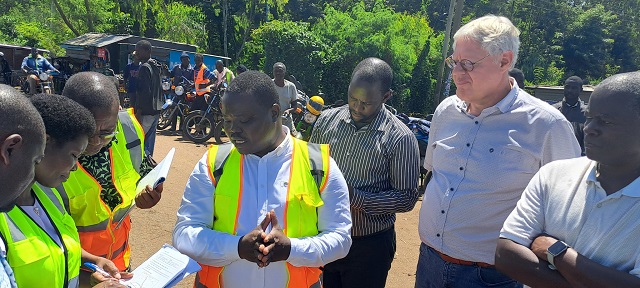
Intra-regional trade within the East African Community with the exclusion of Somalia and DRC is more than US$10.17 billion
Kampala, Uganda | THE INDEPENDENT | Feasibility studies for the proposed 256km Kenya-Uganda Expressway on the Northern Corridor are set to commence following the official handover of the site to GOPA Infra Gmbh of Germany and ITEC Limited of Kenya.
The expressway will extend from Kisumu in Kenya to Kakira in Uganda’s Jinja district, enhancing the existing route with bitumen standards and upgrading a 104km portion into a two-lane dual carriageway.
Funded by a $1.4 million grant from the African Development Bank (AfDB), the feasibility study will assess the economic viability of upgrading the current road sections from a single to a dual carriageway.
The project will be executed in two distinct phases to evaluate the potential for developing the transport links connecting the two countries with the port of Mombasa.
The expressway is crucial for the Northern Corridor, which provides landlocked East African nations with accelerated access to Mombasa Port. It is also a segment of the Mombasa-Kigali expressway, prioritized during the EAC Heads of States Retreat on Infrastructure Development in February 2018 in Kampala.
“The rehabilitation along the EAC Northern Corridor aims to strengthen road infrastructure within the region, promote regional integration, and boost cross-border trade,” said Aguer Ariik Malueth, EAC Deputy Secretary General in charge of Infrastructure, Productive, Social, and Political Sectors, during the site handover ceremony in Kisumu on April 24.
Ariik noted that the feasibility study is expected to last 18 months and highlighted the broader impact of the project. “The upgrade of the Kisumu-Kisian-Busia/Kakira-Malaba-Busitema-Busia expressway will significantly improve transport services to five EAC Partner States, namely Uganda, Rwanda, Burundi, South Sudan, and DRC,” he said.
Ariik also emphasized ongoing efforts across the region: “It is our expectation that Partner States are also in the process of upgrading other sections of the Northern Corridor from Mombasa through Nairobi up to Malaba and from Kampala westwards towards Katuna and Mpondwe to achieve a uniform high level of service along the entire corridor.”
Ariik disclosed that EAC has 10 cross-border corridors that form the EAC Road Network Project totaling 15,000 kilometers, adding that the focus of the EAC Secretariat is to promote their improvements for the enhancement of the economic well-being of all EAC citizens.
Studies to include One Stop Border Posts
Additionally, the feasibility study will also cover improvements at the Busia and Malaba One Stop Border Posts (OSBPs) and propose the upgrading of the Lwakhakha Border between Kenya and Uganda to an OSBP. “The consultant is expected to propose additional measures including the digitalization of weighbridges, establishment of roadside rest areas, and an intelligent transport system,” Ariik added.
Eng. Godfrey A. Enzama, Principal Civil Engineer at the EAC Secretariat, said the “The road project will not only improve transport flow but also address poor road safety, which is a significant issue along some sections of the Northern Corridor.”
Representing the Principal Secretary at Kenya’s Ministry of EAC, ASALs and Regional Development, Eng. Luka Kameli said: “The rehabilitation of the expressway will boost most economic sectors including imports, exports, and the production and delivery of various goods and services across the region.”
This development coincides with Uganda’s plans to construct the Jinja-Kampala Expressway, projected to cost US $1.4 billion. This initiative promises to streamline and expedite transport between Kisumu and Kampala.
In addition, efforts are underway in Kampala to progress the Standard Gauge Railway, which will connect to Kenya’s city of Kisumu, significantly enhancing cargo movement efficiency. The Ugandan government has already made considerable investments in compensations, with residents of Jinja being the most recent beneficiaries.
Intra-regional trade within the EAC has been experiencing robust growth, reaching US$10.17 billion as of September 2022. From 2019, when intra-EAC trade accounted for 13% of total trade with a value of $7.1 billion, it increased to 15% in 2021, valued at $9.5 billion.
This statistics, however, do not include the bloc’s trade with Somalia and the Democratic Republic of Congo that joined EAC in 2022 and 2023, respectively.
 The Independent Uganda: You get the Truth we Pay the Price
The Independent Uganda: You get the Truth we Pay the Price



